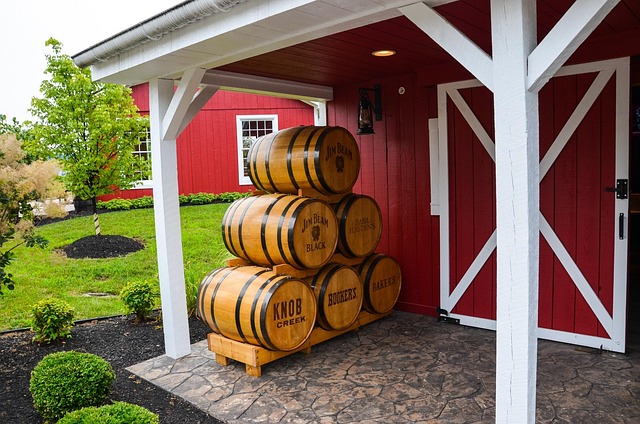Glue Laminated Beams (GLBs) surpass Solid Wood Beams in structural performance, offering superior strength, durability, and fire resistance due to advanced manufacturing techniques. While solid wood beams have natural beauty, GLBs provide enhanced load-bearing capacity, stability, and environmental resilience, making them a sustainable choice for builders and designers.
In construction, understanding the structural differences between Glue Laminated Beams (GLBs) and Solid Wood Beams is paramount for optimal design choices. This article delves into the comparative performance of these lamination types across key metrics. We explore GLB’s structure and strength, solid wood beam characteristics including durability, load-bearing capacity, and environmental sustainability considerations. By the end, readers will grasp which material excels in specific applications, facilitating informed decisions between Glue Laminated Beams vs. Solid Wood Beams.
- Understanding Glue Laminated Beams: Structure and Strength
- Solid Wood Beam Characteristics: Natural Beauty and Durability
- Load-Bearing Capacity Comparison: Who Comes Out Top?
- Environmental Impact and Sustainability: A Green Perspective
Understanding Glue Laminated Beams: Structure and Strength

Understanding Glue Laminated Beams: Structure and Strength
In the realm of structural engineering, Glue Laminated Beams (GLBs) have emerged as a powerful alternative to traditional Solid Wood Beams. GLBs are created by gluing together multiple layers of wood, forming a composite beam with exceptional strength and durability. This modern construction method offers several advantages over solid wood, particularly in terms of strength & durability comparison, longevity, and sustainability. When it comes to which beam type is best for structural integrity, GLBs often prove their mettle, providing a cost-effective solution without compromising on quality.
The benefits of glue lamination are evident in its ability to distribute load more evenly, resulting in superior load-bearing capacity compared to solid wood. This makes GLBs ideal for various architectural designs, ensuring structural reliability and fire resistance. Moreover, the composition of laminated beams allows for greater flexibility in customization while maintaining visual appeal. For those considering construction or renovation, visiting us at 18 Clifton St, Unadilla, NY 13849 anytime can provide valuable insights into choosing between solid wood and glue laminated beams, enabling informed decisions for any project.
Solid Wood Beam Characteristics: Natural Beauty and Durability

Solid wood beams have long been celebrated for their natural beauty and durability, making them a popular choice in architectural design. The aesthetic appeal of solid wood is undeniable, with its warm tones and grain patterns adding character to any space. However, when it comes to structural performance, other lamination types, particularly glue laminated beams, offer significant advantages.
In comparison to solid wood, glue laminated beams are engineered to provide superior strength and stability. The process involves gluing together multiple layers of lumber, creating a composite material that surpasses the properties of individual boards. This method enhances both the tensile and compressive strength of the beam, making it an excellent choice for load-bearing applications. Unlike solid wood, which can bend or warp over time due to fluctuations in humidity, laminated beams are more resistant to environmental factors, ensuring structural integrity for years to come. Moreover, with advancements in adhesive technology, modern glue laminations offer improved bond strength and dimensional stability, giving them an edge over traditional solid wood construction.
Load-Bearing Capacity Comparison: Who Comes Out Top?

When it comes to load-bearing capacity, both Glue Laminated Beams and Solid Wood Beams have their strengths, but a direct comparison reveals some notable differences. In terms of raw strength, Glue Laminated Beams often come out on top due to the advanced manufacturing process that utilizes high-quality adhesives and precise techniques. This method creates a beam with exceptional structural integrity, capable of supporting significant loads without compromising durability.
In contrast, Solid Wood Beams, while aesthetically appealing and offering a natural beauty, may not match the load-bearing capacity of their laminated counterparts. The variability in wood density and grain structure can lead to inconsistencies in strength. However, it’s essential to note that modern solid wood construction techniques and specialized treatments can enhance these beams’ performance, making them suitable for various applications. Ultimately, the choice between Glue Laminated Beams and Solid Wood depends on specific project requirements, budget, and desired aesthetics, with both options providing reliable structural support when used appropriately.
Environmental Impact and Sustainability: A Green Perspective

In today’s world, where environmental sustainability is a paramount concern, the construction industry is increasingly focusing on eco-friendly alternatives. When comparing Glue Laminated Beams vs Solid Wood, it becomes evident that laminating technology offers a compelling green perspective. The production of glue laminated beams involves advanced wood bonding techniques, utilizing high-quality adhesives to create strong, durable structures without the need for extensive solid wood processing. This method significantly reduces waste and energy consumption compared to traditional solid wood beam fabrication.
In terms of structural performance, Glue Laminated Beams often surpass their solid wood counterparts. They provide superior strength-to-weight ratio, making them ideal for load-bearing applications. Moreover, the lamination process enhances the overall longevity of the beams, resisting warping and rot. For builders and designers looking to incorporate sustainable practices without compromising on structural integrity, laminated beams present a compelling solution. Give us a call at (607) 369-9341 to explore how these innovative options can contribute to your next project’s success while minimizing environmental impact.
In comparing the structural performance of glue laminated beams and solid wood beams, both exhibit unique advantages. Glue laminated beams offer exceptional strength and stability due to their cross-linked structure, making them ideal for heavy load-bearing applications. On the other hand, solid wood beams possess natural beauty and durability, providing a sustainable and aesthetically pleasing option. Considering environmental impact, glue laminating reduces waste compared to solid wood processing. However, in terms of overall structural performance, when properly specified and installed, both lamination types can excel, catering to specific project needs while promoting eco-friendly practices.














